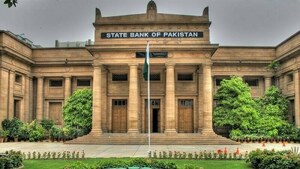Pakistan’s Economy Shows Improvement in First Half of FY25
Pakistan’s macroeconomic situation saw significant improvement during the first half of fiscal year 2025, with key indicators displaying notable progress. The rate of inflation decreased to its lowest level in several years by March 2025. Furthermore, the current account showed a surplus, which strengthened foreign exchange reserves. The fiscal deficit was also kept at its lowest level in two decades, aided by a record surplus in the primary balance.
The State Bank of Pakistan (SBP) released its “State of Pakistan’s Economy” Half Year Report FY25, which stated that the positive outcomes were primarily a result of a well-thought-out monetary policy, fiscal measures, stable global commodity prices, and the approval of the IMF’s Extended Fund Facility (EFF) program. The report also noted that international agencies had upgraded the nation’s credit rating, recognizing the improving economic climate.
Decline in Inflationary Pressures
The report emphasized that inflationary pressures have considerably reduced, with headline inflation dropping to 0.7 percent by March 2025, a multi-year low. This significant decrease in inflation was due to several factors, including a strict monetary policy and fiscal measures that controlled domestic demand, better supply conditions, a break in energy price adjustments, and moderate international commodity prices.
Due to the easing of inflationary pressures and a better outlook on inflation, the SBP lowered the policy rate by 1000 basis points between June 2024 and February 2025. The report also mentioned that the subsequent easing of financial conditions, combined with a small increase in economic activity and ADR-related lending, led to considerable growth in private sector credit during H1-FY25.
Real GDP Growth Moderation
The moderation in real GDP growth was attributed to decreased production of vital Kharif crops and a contraction in industrial activity during H1-FY25. The broad-based decline in Kharif crops was linked to a decrease in the area under cultivation and lower yields.
The report highlighted the importance of uncertainty in agricultural policy, low crop prices last year, unfavorable weather conditions, and reduced use of certified seeds and other inputs for the poor performance.
It was also mentioned that the industry contracted less during H1-FY25 compared to the previous year, supported by small-scale manufacturing, utilities, and slaughtering, while mining & quarrying, construction, and large-scale manufacturing had negative impacts. Moreover, the services sector performed relatively better in H1-FY25 compared to the same period last year.
The report noted that a steady increase in exports and remittances from workers during H1-FY25 offset a significant rise in imports, resulting in a current account surplus. These factors, along with the distribution of the first tranche under the IMF’s EFF and a slight increase in private inflows, strengthened the SBP’s FX reserves.
Competitiveness and Productivity
The report features a dedicated chapter titled ‘Pakistan’s Low Competitiveness: A Case for Investing in Productivity.’ The analysis points out that the country’s economic competitiveness has been negatively impacted over time by weak growth in labor productivity and total factor productivity, which has led to frequent boom-bust cycles.
The chapter reveals that Pakistan’s performance has been noticeably weak over time compared to similar economies across most drivers of productivity and related structural factors. As a result, it emphasizes the importance of addressing the macroeconomic and structural barriers to productivity growth. Various sections of the report highlight structural challenges in the economy, offering relevant recommendations based on international experiences.
Pakistan’s central bank stated in its half-yearly economic report that average inflation for the fiscal year ending in June 2025 is anticipated to be between 5.5 and 7.5 percent, with no adjustments to the real GDP growth projection of 2.5–3.5 percent.



Comments (0)
No comments yet. Be the first to comment!
Leave a Comment